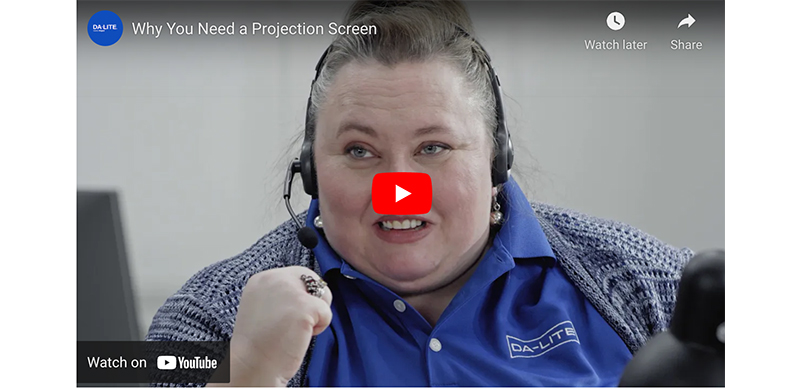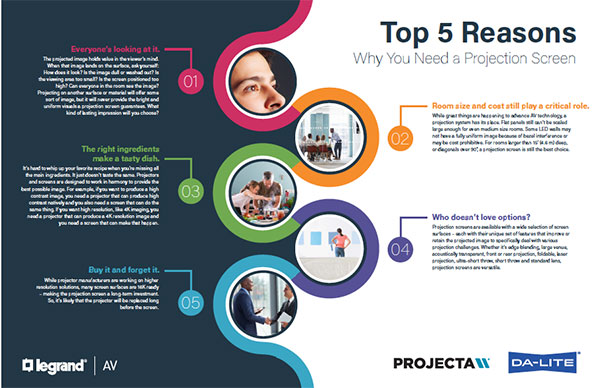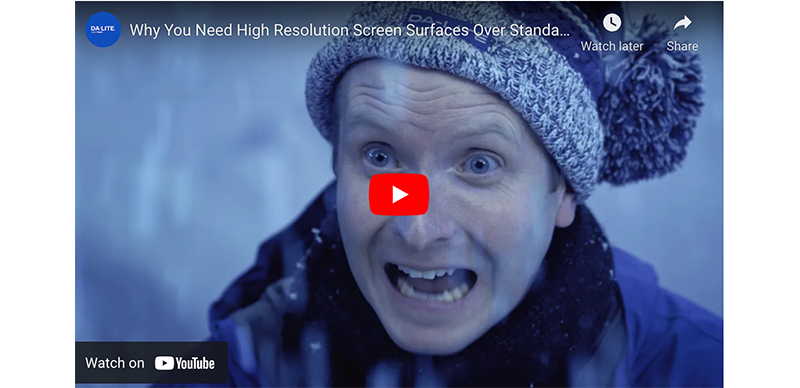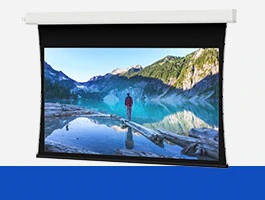Three Top Five Lists from Da-Lite
When you are a commercial projection screen manufacturer, you get to field a lot of questions from customers and end users. When you are passionate about providing the best experience with AV technology, you love answering them.
What we have here are three top 5 lists of questions we often get, or questions dealers get from their customers. Be prepared the next time someone says they’ll just use the office wall for their projection image. We’ve organized them into three categories: Why screens, why high resolution, and why ambient light rejection.
Top 5 Reasons Why You Need a Projection Screen
Everyone’s looking at it.
The projected image holds value in the viewer’s mind. When that image lands on the surface, ask yourself: How does it look? Is the image dull or washed out? Is the viewing area too small? Is the screen positioned too high? Can everyone in the room see the image?
Projecting on another surface or material will offer some sort of image, but it will never provide the bright and uniform visuals a projection screen guarantees. What kind of lasting impression will you choose?
Room size and cost still play a critical role.
While great things are happening to advance AV technology, a projection system has its place. Flat panels still can't be scaled large enough for even medium size rooms. Some LED walls may not have a fully uniform image because of bezel interference or may be cost prohibitive. For rooms larger than 15’ (4.6 m) deep, or diagonals over 90” (228 cm), a commercial projection screen is still the best choice.
The right ingredients make a tasty dish.
It’s hard to whip up your favorite recipe when you’re missing all the main ingredients. It just doesn’t taste the same. Projectors and screens are designed to work in harmony to provide the best possible image. For example, if you want to produce a high contrast image, you need a projector that can produce high contrast natively and you also need a screen that can do the same thing.
If you want high resolution, like 4K imaging, you need a projector that can produce a 4K resolution image and you need a screen that can make that happen.
Who doesn’t love options?
Projection screens are available with a wide selection of screen surfaces – each with their unique set of features that improve or retain the projected image to specifically deal with various projection challenges. Whether it’s edge blending, large venue, acoustically transparent, front or rear projection, foldable, laser projection, ultra-short throw, short throw and standard lens, projection screens are versatile.
Buy it and forget it.
While projector manufacturers are working on higher resolution solutions, many screen surfaces are 16K ready – making the projection screen a long-term investment. So, it’s likely that the projector will be replaced long before the screen.
Download our infographic on this issue.
OK, we’ve covered why you need a projection screen. But how does screen surface quality come into the picture (see what we did there)? We have a top 5 list for that.
Top 5 Reasons Why You Need High Resolution Screen Surfaces Over Standard Resolution Screen Surfaces
Resolution keeps getting higher and higher.
The HD Progressive family of commercial screen surfaces are designed for technology today and tomorrow.
Future-proof your investment.
While projector manufacturers are working on higher resolution solutions, HD Progressive screen surfaces are 16K ready when the market’s ready. Yep – you heard us right.
Your screen needs to be the same quality as your projector.
The market has become saturated with HD and 4K projectors. They are readily available and appear in installations everywhere. Optimize this technology with screen surfaces specifically designed for 1080p/WUXGA/4K projectors.
Tensioned screens provide an ultra-flat image surface when detail is needed.
HD Progressive surfaces ensure an even distribution of projected light for ideal image uniformity. It’s smooth. Those pixels don’t change.
You want what you want when you want it.
That’s why we introduced the family of HD Progressive surfaces – designed with a range of features considering your many applications and installation needs. Whether it’s edge blending, large venue, acoustically transparent, front or rear projection, foldable, laser projection, ultra-short throw, short throw and standard lenses, this line is feature rich.
Download the infographic about this topic.
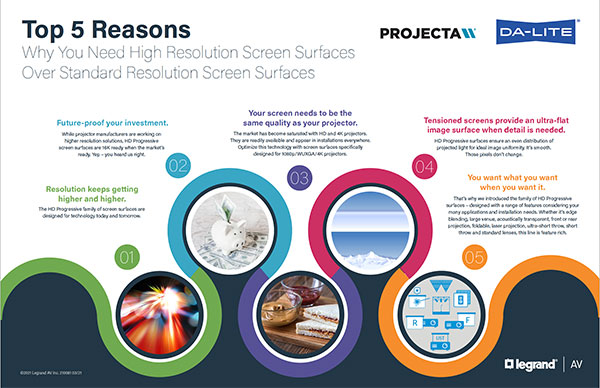
Ok, you’re aware of the relationship between high resolution surfaces and projectors, but what if there’s bears ambient light? Strap your peepers on this top 5!
Top 5 Reasons Why You Need ALR Screen Technology
Ambient light will always be a part of the projection equation.
Ambient light, natural (sunlight) or artificial (interior room lights), can come from any source in a room. In two-piece projection, the only light you want hitting the screen is from the projector. Screen surfaces featuring Ambient Light Rejection (ALR) properties can separate light in the environment from projected light.
Rooms aren’t so dark anymore.
Current trends in construction and architecture are focused on open plan layouts that bring natural elements and energy-efficient alternatives like LED without controlling or concealing all the desired light with dimmers or shades.
Dull, washed out images aren’t a good look.
Ambient light that falls on a standard projection screen will compete with light from the projector and wash out image contrast, color saturation and dynamic range, affecting the viewing experience. Da-Lite’s Parallax® Family of Market-Leading Ambient Light Rejecting Screen Surfaces are designed to preserve high contrast images in the brightest of environments.
The game has evolved. Has yours?
You know you want to be the tech-forward professional! Expand your product portfolio and installation opportunities by offering screen technology that can handle oodles of ambient light.
Product technology continues to evolve.
Whether you’re looking for up to 16K ready technology or up to 16’ (4.9 m) high seamless offerings, Da-Lite’s Parallax surfaces fit the bill.
Download the infographic on this topic.
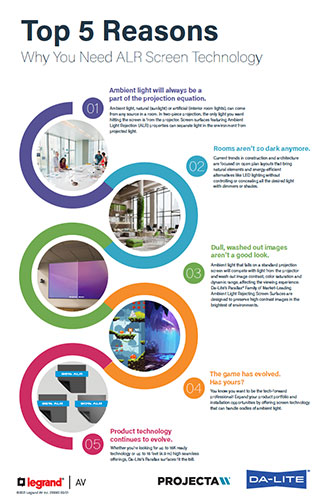
And there you have it. Do you have more questions? We look forward to hearing them! We’re listening.
We also have other great tools:
Screen Surface Selection Calculator
There's a Class For That
Two Piece Projection Basics
Learn how to quickly and easily right-size the display to the room and how to choose the right format for the projector. (1.25 CTS)
Why High Resolution Screen Surfaces?
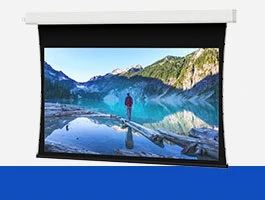
Learn why image uniformity matters and how optimal image quality is achieved in screen surfaces pairings with high-resolution projectors. (0.50 CTS)
Related Inspiration
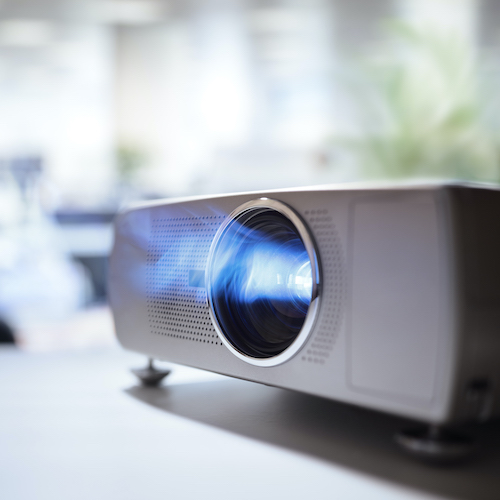 How do new projection technologies affect the digital signage experience? What should you consider when trying to make projection-based digital signage stand out?
How do new projection technologies affect the digital signage experience? What should you consider when trying to make projection-based digital signage stand out? 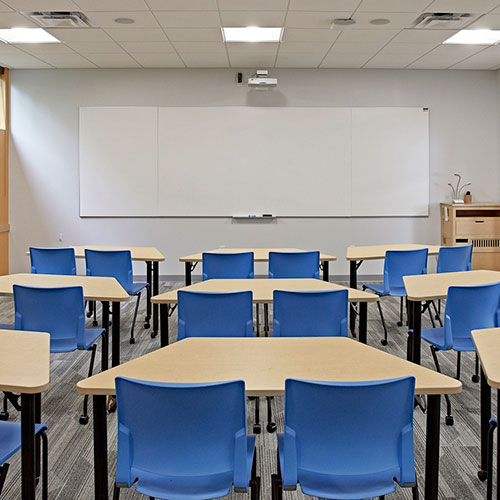 We put all our top projector screen picks for K-12 and higher education in one blog along with our favorite resources.
We put all our top projector screen picks for K-12 and higher education in one blog along with our favorite resources. 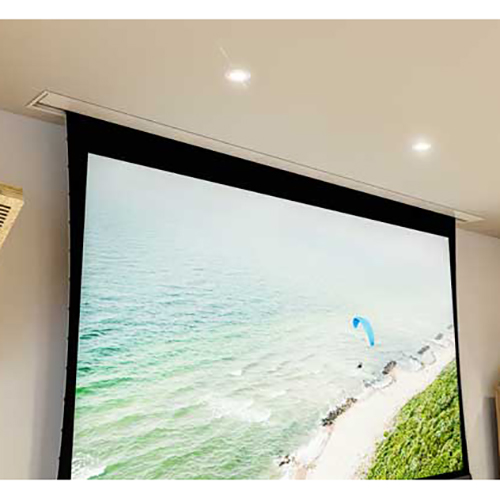 Explore how to correctly pair projectors with projection screens to maintain image color, brightness and resolution.
Explore how to correctly pair projectors with projection screens to maintain image color, brightness and resolution.



